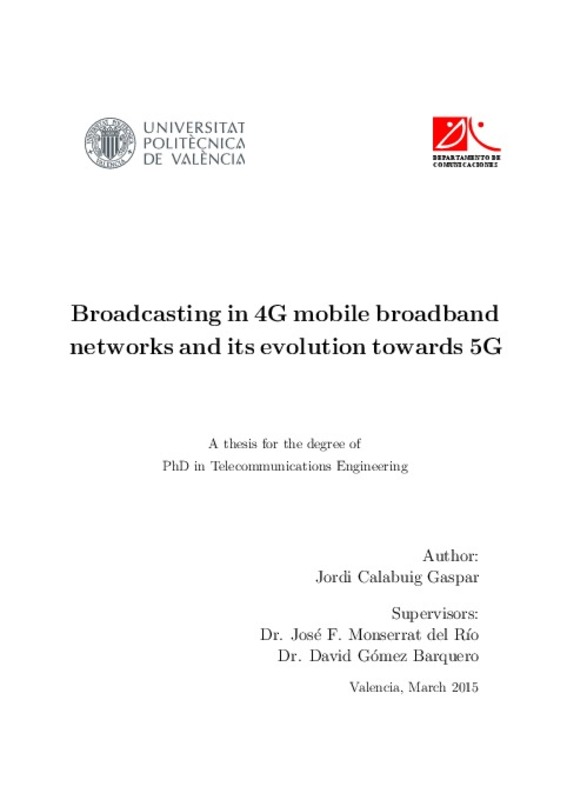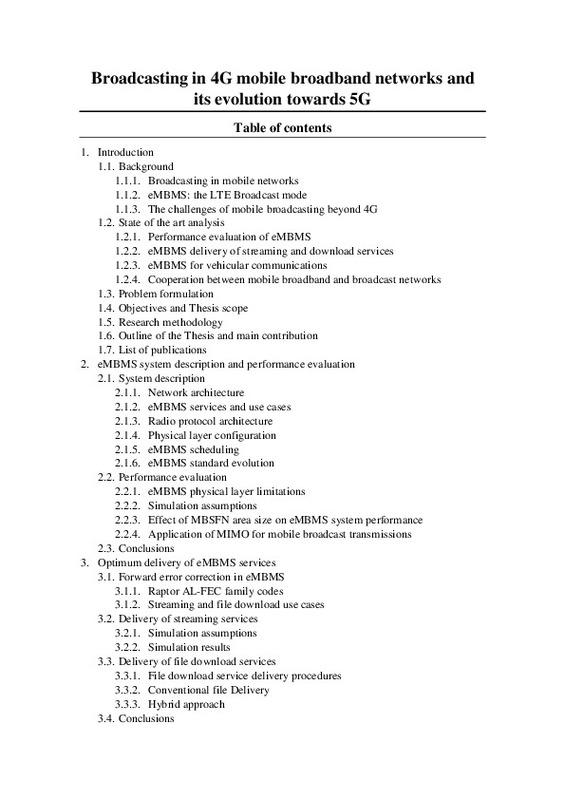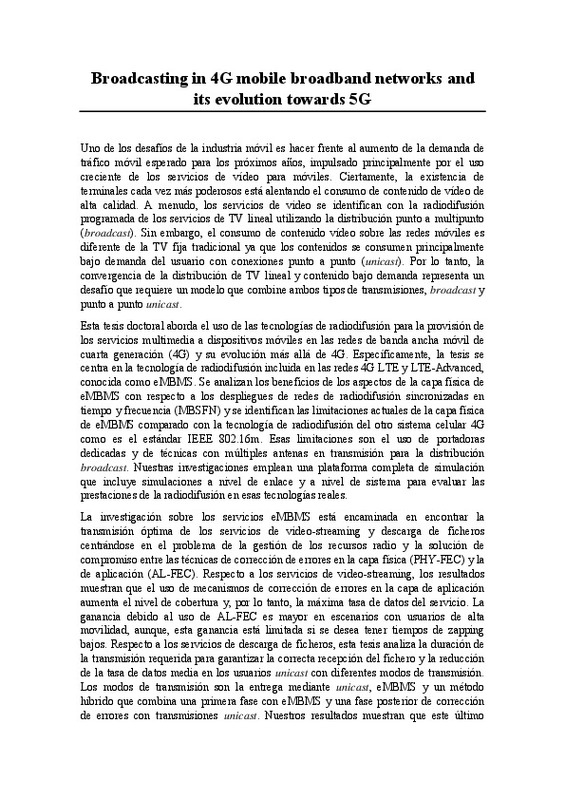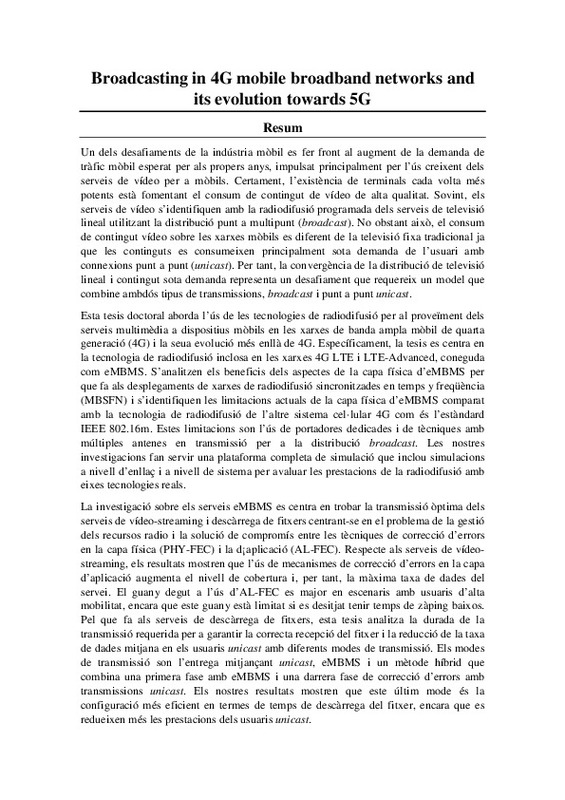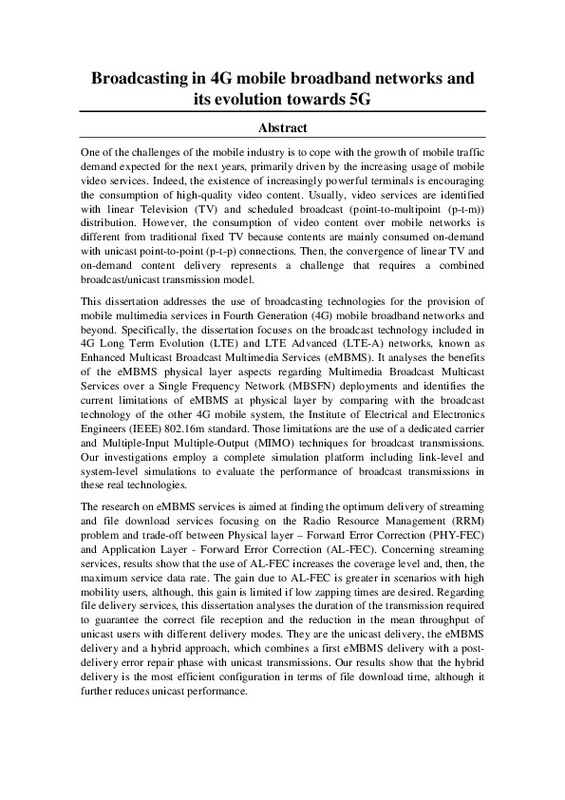- RiuNet repositorio UPV
- :
- Investigación
- :
- Tesis doctorales
- :
- Ver ítem
JavaScript is disabled for your browser. Some features of this site may not work without it.
Buscar en RiuNet
Listar
Mi cuenta
Estadísticas
Ayuda RiuNet
Admin. UPV
Broadcasting in 4G mobile broadband networks and its evolution towards 5G
Mostrar el registro sencillo del ítem
Ficheros en el ítem
| dc.contributor.advisor | Gómez Barquero, David
|
es_ES |
| dc.contributor.advisor | Monserrat del Río, José Francisco
|
es_ES |
| dc.contributor.author | CALABUIG GASPAR, JORGE
|
es_ES |
| dc.date.accessioned | 2015-03-31T06:12:22Z | |
| dc.date.available | 2015-03-31T06:12:22Z | |
| dc.date.created | 2015-03-03 | es_ES |
| dc.date.issued | 2015-03-31 | es_ES |
| dc.identifier.uri | http://hdl.handle.net/10251/48561 | |
| dc.description.abstract | One of the challenges of the mobile industry is to cope with the growth of mobile traffic demand expected for the next years, primarily driven by the increasing usage of mobile video services. Indeed, the existence of increasingly powerful terminals is encouraging the consumption of high-quality video content. Usually, video services are identified with linear Television (TV) and scheduled broadcast (point-to-multipoint (p-t-m)) distribution. However, the consumption of video content over mobile networks is different from traditional fixed TV because contents are mainly consumed on-demand with unicast point-to-point (p-t-p) connections. Then, the convergence of linear TV and on-demand content delivery represents a challenge that requires a combined broadcast/unicast transmission model. This dissertation addresses the use of broadcasting technologies for the provision of mobile multimedia services in Fourth Generation (4G) mobile broadband networks and beyond. Specifically, the dissertation focuses on the broadcast technology included in 4G Long Term Evolution (LTE) and LTE Advanced (LTE-A) networks, known as Enhanced Multicast Broadcast Multimedia Services (eMBMS). It analyses the benefits of the eMBMS physical layer aspects regarding Multimedia Broadcast Multicast Services over a Single Frequency Network (MBSFN) deployments and identifies the current limitations of eMBMS at physical layer by comparing with the broadcast technology of the other 4G mobile system, the Institute of Electrical and Electronics Engineers (IEEE) 802.16m standard. Those limitations are the use of a dedicated carrier and Multiple-Input Multiple-Output (MIMO) techniques for broadcast transmissions. Our investigations employ a complete simulation platform including link-level and system-level simulations to evaluate the performance of broadcast transmissions in these real technologies. The research on eMBMS services is aimed at finding the optimum delivery of streaming and file download services focusing on the Radio Resource Management (RRM) problem and trade-off between Physical layer – Forward Error Correction (PHY-FEC) and Application Layer - Forward Error Correction (AL-FEC). Concerning streaming services, results show that the use of AL-FEC increases the coverage level and, then, the maximum service data rate. The gain due to AL-FEC is greater in scenarios with high mobility users, although, this gain is limited if low zapping times are desired. Regarding file delivery services, this dissertation analyses the duration of the transmission required to guarantee the correct file reception and the reduction in the mean throughput of unicast users with different delivery modes. They are the unicast delivery, the eMBMS delivery and a hybrid approach, which combines a first eMBMS delivery with a postdelivery error repair phase with unicast transmissions. Our results show that the hybrid delivery is the most efficient configuration in terms of file download time, although it further reduces unicast performance. | en_EN |
| dc.language | Inglés | es_ES |
| dc.publisher | Universitat Politècnica de València | es_ES |
| dc.rights | Reserva de todos los derechos | es_ES |
| dc.subject | Broadcasting | es_ES |
| dc.subject | 4G | |
| dc.subject | LTE | |
| dc.subject | eMBMS | |
| dc.subject | Mobile video | |
| dc.subject | 5G | |
| dc.subject.classification | TEORIA DE LA SEÑAL Y COMUNICACIONES | es_ES |
| dc.title | Broadcasting in 4G mobile broadband networks and its evolution towards 5G | es_ES |
| dc.type | Tesis doctoral | es_ES |
| dc.identifier.doi | 10.4995/Thesis/10251/48561 | es_ES |
| dc.rights.accessRights | Abierto | es_ES |
| dc.contributor.affiliation | Universitat Politècnica de València. Departamento de Comunicaciones - Departament de Comunicacions | es_ES |
| dc.description.bibliographicCitation | Calabuig Gaspar, J. (2015). Broadcasting in 4G mobile broadband networks and its evolution towards 5G [Tesis doctoral]. Universitat Politècnica de València. https://doi.org/10.4995/Thesis/10251/48561 | es_ES |
| dc.description.accrualMethod | TESIS | es_ES |
| dc.type.version | info:eu-repo/semantics/acceptedVersion | es_ES |
| dc.relation.pasarela | TESIS\8323 | es_ES |
Este ítem aparece en la(s) siguiente(s) colección(ones)
-
Tesis doctorales [5389]






